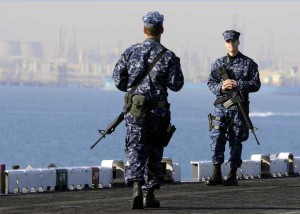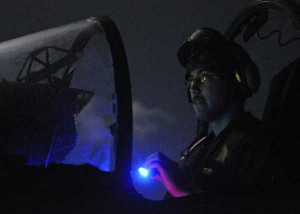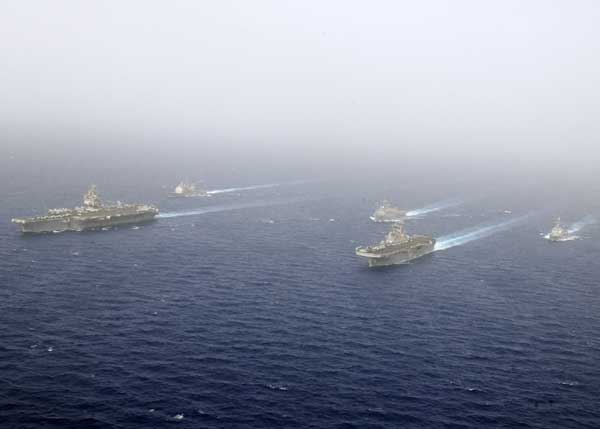An Interview With Colonel Mark Desens, Commander of the 26th MEU
09/05/2011 – In July 2011, Second Line of Defense sat down with Colonel Mark Desens to discuss the recent deployment of the 26th Marine Expeditionary Unit. Earlier we had discussed, with Col. “Ozzie” Osborn, the 15th MEU, the evolution of the ARG as a very flexible combat structure and set of assets.
Colonel Desens led the 26th MEU through two deployments:
- the first in Sept. 2008 – April 2009
- and most recently Aug. 2010 – May 2011.
His deployments included exercises throughout the Central and Africa Commands, and operations in Pakistan, Afghanistan, and Libya. Indeed, one might refer to the Agile Response Group rather than to the Amphibious Ready Group. We crafted a slideshow, which shows the flexibility of the ARG during a deployment. The 26th MEU is shown during its multi-month deployment, which included Operation Odyssey Dawn. We noted at the time that “it is clear that the range of operations capable of being executed concurrently is not widely grasped in the strategic community.”
In this interview, Colonel Desens shares his thinking about the challenges of aggregating and disaggregating an ARG/MEU during a deployment, while providing us with some insight with regard to the Libyan operations as well.
Ships of the Kearsarge Amphibious Ready Group and the Enterprise Carrier Strike Group steam in close formation for a scheduled photographic exercise known as a PHOTOEX. (Credit: USN Visual Service 2/16/2011)
SLD: Could you discuss the challenges of aggregating and disaggregating an ARG/MEU during a deployment?
Colonel Desens: We need to aggregate for combat. We better be good at that because it could cost you lives otherwise. We also aggregate for missions that require the whole MAGTF, (Marine Air-Ground Task Force) such as a major humanitarian aid mission. The centerpiece of doing this effectively is robust Command and Control. We are finally catching up a bit with the Carrier Strike Groups in regards to C2 ,but have a ways to go, especially when we consider future employment scenarios. Our newer amphibious ships, like the LPD-17 (Landing Platform Dock), offer greater potential, given the proper theater-level support. If we are to view and employ our future LHA-6 class of Amphibious Assault ships, with the F-35B, as “Lightning Carriers,” then we must ensure that our LHAs have the commensurate combat and information systems to play in that arena. In my recent deployment, the fact that we had battle hardened Marines with significant experience on the land, provided a solid basis for both MEU/Battalion-level operations, as well as independent tasks. I believe there will be a premium on our ability to train to and employ these capabilities in the future.
SLD: On the recent deployment, could you give us a sense of covered by your disaggregated ops?
Colonel Desens: In the middle of November 2010, we were spread over 3,000 miles ranging from Kenya, to Jordan, to Djibouti to Pakistan. We concurrently supported three Combatant Commanders. This is not unique to our deployment.
SLD: When you’re operating over such a large area, the challenge is to put the resources up against the priority missions?
Colonel Desens: Right. Every day you’re looking at a mission. Do I have the capabilities matched up correctly? Tomorrow, by the way, that mission stands down, and a new one stands up over here. Are you postured correctly for it? Do you have the C2, mobility, and logistical support? Force Protection? How am I migrating command and control, to include satellite coverage? How am I using my aircraft? What are the Combatant and Component Commanders providing? What’s theater and organic lift doing for me? The MV-22, by the way, has become a game changer in this discussion. Moreover, our organic KC-130s are ubiquitous and a key enabler to everything we do.
Then there is the people piece. We need small teams that we can task organize and put into unfamiliar environments and know they will succeed. We’re talking about small, maybe five man teams, with a sergeant in charge. So does that sergeant understand what I want him to do if I can’t talk with him through the C2 system? In order to conduct truly disaggregated operations, you have to use a lot of commander’s intent and have built trust and confidence into your Marines and sailors.
In order to conduct truly disaggregated operations, you have to use a lot of commander’s intent and have built trust and confidence into your Marines and sailors.

Should I have the ability to pick up my smart phone, and talk to anybody in the 2,400 people in the MEU anywhere, any time? Technically a good idea, but from a command and control point of view, completely unpractical. There’s a term used these days called “Mission Command.” The Marine Corps has lived this for a long time. I believe that was a key to our recent success.
SLD: So walk us through the situation as you approached the Libyan operation?
Colonel Desens: In the January time frame, we put almost 1,400 people into Afghanistan. Lebanon kind of simmers with the Special Tribunal and gets on our radar screen. Then Tunisia goes upside down. We’re between the Gulf of Aden and other missions at this time. We’re reconstituting our TRAP (Tactical Recovery of Aircraft and Personnel) capability. We’re reconstituting our NEO (Noncombatant Evacuation Operations) capability. Both were lost or degraded when we split the MEU for Afghanistan.
We’re reconstituting our TRAP (Tactical Recovery of Aircraft and Personnel) capability. We’re reconstituting our NEO (Noncombatant Evacuation Operations) capability. Both were lost or degraded when we split the MEU for Afghanistan.
At the end of February, the USS Kearsarge (LHD3), USS Ponce (LPD15) are together. The USS Enterprise (a large deck aircraft carrier) has come through the Med, and through the Suez Canal. So all three ships are now at the northern end of the Red Sea. February is when Libya starts warming up. As we do our mission analysis, job one is to protect American citizens. So, the first thing on our mind is NEO. Folks are talking about potential humanitarian assistance operations, not so much in Libya itself, but crossing the border into Egypt and Tunisia.
As we looked towards what would become Operation Odyssey Dawn, it was clear the maritime forces would be significant players. On the second of March, Kearsarge and Ponce go through the Suez. Marines with 1st Battalion, 2nd Marine Regiment, augmented 26th Marine Expeditionary Unit, and boarded the USS Kearsarge at Souda Bay, Greece on March 4th. By the 7th of March, we were off Benghazi ready to go to do our missions.
The logistics of the situation made it clear that the maritime operational bases were clearly critical to the operations. The nearest non-naval attack aircraft are coming out of Aviano, Italy. That’s about 1,000 miles north of Benghazi. For a fixed wing guy, that’s at least one tank (aerial refueling) just to get to work, one tank to get back, and probably a tank in between. Whereas, with a big deck amphib in the Gulf of Sidra, the average commute was 100 miles.
The logistics of the situation made it clear that the maritime operational bases were clearly critical to the operations. The nearest non-naval attack aircraft are coming out of Aviano, Italy. That’s about 1,000 miles north of Benghazi. For a fixed wing guy, that’s at least one tank (aerial refueling) just to get to work, one tank to get back, and probably a tank in between. Whereas, with a big deck amphib in the Gulf of Sidra, the average commute was 100 miles.
Sailors assigned to the deck department aboard the amphibious transport dock ship USS Ponce (LPD 15) prepare for a replenishment at sea with the fleet replenishment oiler USNS Kanawha (T-AO 196) and the Amphibious assault ship USS Kearsarge (LHD 3). Credit: USN Visual Service, 3/10/11
On the 18th of March, Gaddafi’s forces are shelling the outskirts of Benghazi and we’re a bit concerned about doing everything from the air. If you’re doing everything from the air, you can do a lot until a guy is into an urban fight. And then you become somewhat limited.
On the 19th, we get the first air strikes. As the ATO [Air Tasking Order] shook out, the Marines ended up being the last ones to fly that night. However, there’s a silver lining in every cloud. The litening pod, integrated on the AV-8B Harrier II, is one of the best things ever invented.
The beauty of us coming in towards the end of the night is we were able to go do a complete run with a litening pod up and down the roads south of Benghazi, record everything in that battlespace, and do all the processing in quick order aboard the Kearsarge. We shared everything we had with the JFACC (Joint Forces Air Component Commander) who didn’t have UAVs available until a few weeks later. We were able to do a complete analysis from the systems on the Harriers, turn it back around, and start getting ready for the next day.

This is where you start to see the advantages we had by being close to the target area, If I’m coming from Aviano, my data’s at least two and a half hours old. Things may well have moved. So now I have to reacquire to do the things I need to do. On the other hand, if you are only 100 miles away, the intelligence update you walked to the aircraft with is only fifteen minutes old as you enter the target area – and your target is right there waiting for you. We enjoyed a very high target to sortie rate because of tactical intelligence advantage.
The litening pod, integrated on the AV-8B Harrier II, is one of the best things ever invented. The beauty of us coming in towards the end of the night is we were able to go do a complete run with a litening pod up and down the roads south of Benghazi, record everything in that battlespace, and do all the processing in quick order aboard the Kearsarge. (…) if you are only 100 miles away, the intelligence update you walked to the aircraft with is only fifteen minutes old as you enter the target area – and your target is right there waiting for you. We enjoyed a very high target to sortie rate because of tactical intelligence advantage.
SLD: The Ospreys played a key logistical role for your operation as well?
Colonel Desens: Osprey was a game changer. On a couple of occasions, MV-22s flew 500 miles legs to get critical parts to keep the ACE flying. Without the MV-22, the ship would have had to leave station and risk the execution of the mission. From a seabased platform, you really see the impact of the V-22. It’s fine in Afghanistan, but it really shines in the shipboard environment and the speed and range it offers a maritime force.
SLD: Could you speak to the TRAP operation?
Colonel Desens: When we learned that a F-15 crew had ejected east of Benghazi, we immediately focused our efforts on getting ready to rescue them.
The mission was given to us for two reasons: one, first and foremost, was the uncertain environment. We didn’t know what’was going on on the ground with the pilot. The second is we were the most ready and had the most responsive assets, most notably, the MV-22. Backed up by CH-53s and Harriers, we had very potent reaction force in case we needed to fight to get the crew out or reinforce the recovery or crash site. As an aside, a recovery asset launching from land base — the next closest locations being Sigonella or Souda Bay — would have been four or more hours.
There were USAF HH-60G rescue helicopters embarked on the Ponce to give a CSAR capability with improved reaction times. However, you’re comparing 270 knots versus 140. It would have taken at least 45 minutes longer for a helicopter to get there. U.S. forces may well have not been the first to reach that pilot without the MV-22. Given the situation, that was not acceptable. The other thing is that for a helo, a direct flight path (to save time) to the pilot would have gone through Benghazi, a potential threat area at the time. The Osprey could chart a very different path, avoiding any potential air defense threats.
Again the speed and range of the Osprey coupled with the ability to have Marines on the ground to secure the perimeter and Harriers providing air cover meant that the TRAP team could get the job done much more rapidly and safely.
As an aside, a recovery asset launching from land base — the next closest locations being Sigonella or Souda Bay — would have been four or more hours. There were USAF HH-60G rescue helicopters embarked on the Ponce to give a CSAR capability with improved reaction times. However, you’re comparing 270 knots versus 140. It would have taken at least 45 minutes longer for a helicopter to get there. U.S. forces may well have not been the first to reach that pilot without the MV-22. Given the situation, that was not acceptable. The other thing is that for a helo, a direct flight path (to save time) to the pilot would have gone through Benghazi, a potential threat area at the time. The Osprey could chart a very different path, avoiding any potential air defense threats. Again the speed and range of the Osprey coupled with the ability to have Marines on the ground to secure the perimeter and Harriers providing air cover meant that the TRAP team could get the job done much more rapidly and safely.
SLD: We heard that the Kearsarge had some problems during the operation?
Colonel Desens: The Kearsarge had a significant engineering casualty late in Odyssey Dawn. It broke in such a way that they were afraid that if they went too fast, it could cause further damage or endanger personnel. The ship had to lock the shaft in place and the speed of the ship was limited four to six knots. This essentially halted AV-8B operations. The Osprey was key to getting the ship into a repair port quickly by bringing engineering experts to the ship from 400 miles away on short notice. This enabled the ship to resume greater speed to get into port for repairs while Marine air and ground forces repositioned ashore to provide uninterrupted support to Strike and TRAP missions.
The Kearsarge had a significant engineering casualty late in Odyssey Dawn, [… which] essentially halted AV-8B operations. The Osprey was key to getting the ship into a repair port quickly by bringing engineering experts to the ship from 400 miles away on short notice. This enabled the ship to resume greater speed to get into port for repairs while Marine air and ground forces repositioned ashore to provide uninterrupted support to Strike and TRAP missions.
SLD: What is your overall conclusion about the lessons learned for the deployment?
Colonel Desens: The lesson is the tremendous capability, flexibility and agility that a naval Marine Air-Ground Task Force can offer. It is unique in our Nation’s inventory.


